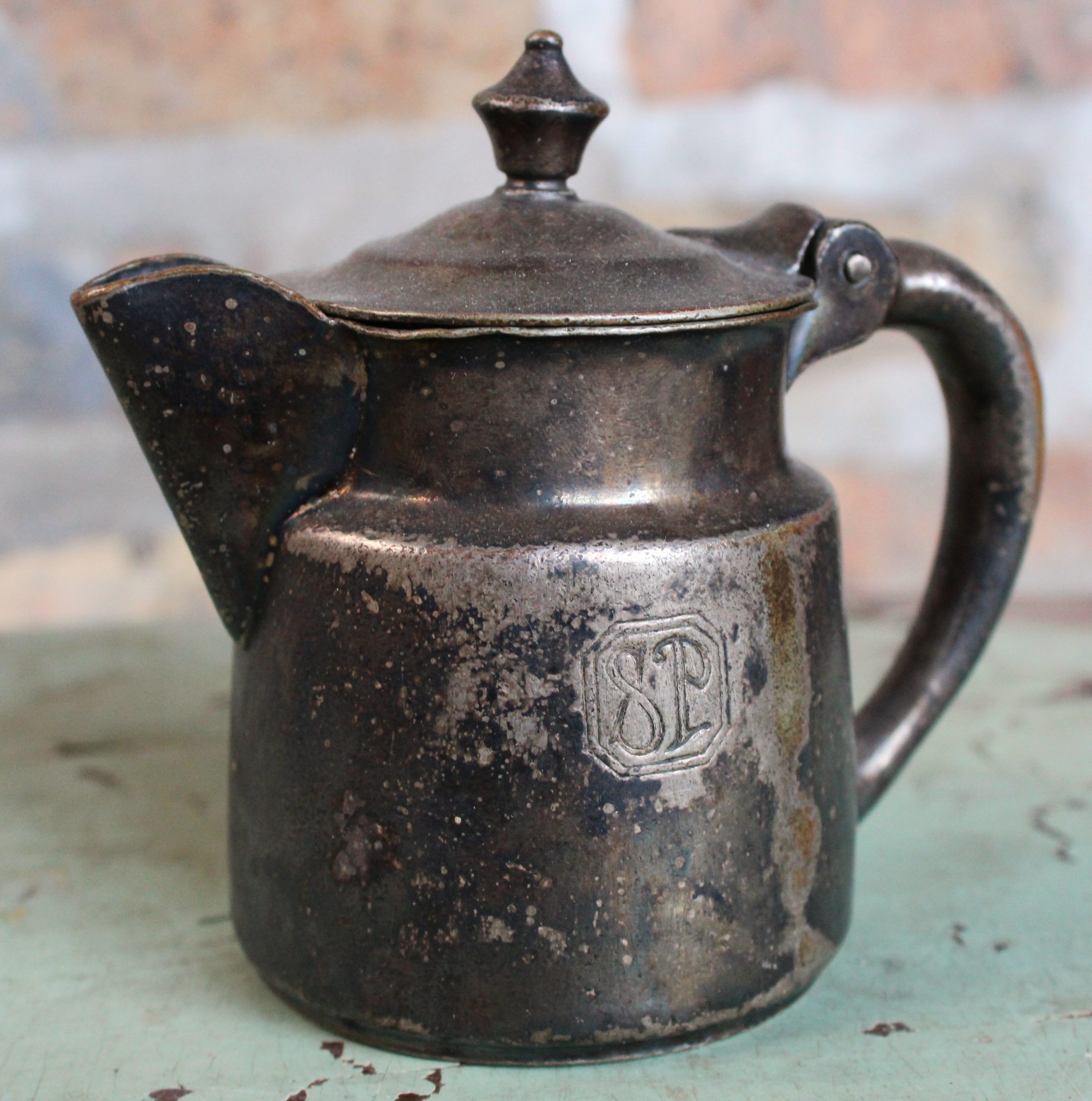
Museum Artifact: Silver Coffee Pot (Sheridan Plaza Hotel), 1920s
Made by: Albert Pick & Company, 1200 W. 35th Street, Chicago, IL [Bridgeport]
“The Sheridan-Plaza Hotel Cafeteria operates from 8 o’clock in the morning until 12 o’clock at night and is always busy. The management of the Sheridan-Plaza, having made thorough study of conditions in the surrounding neighborhood, knew that a cafeteria operating all day and night would be a success. Their next problem was to find equipment that would stand up under heavy strain. Albert Pick & Co. solved this problem for them.”—Albert Pick & Co. advertisement, 1921
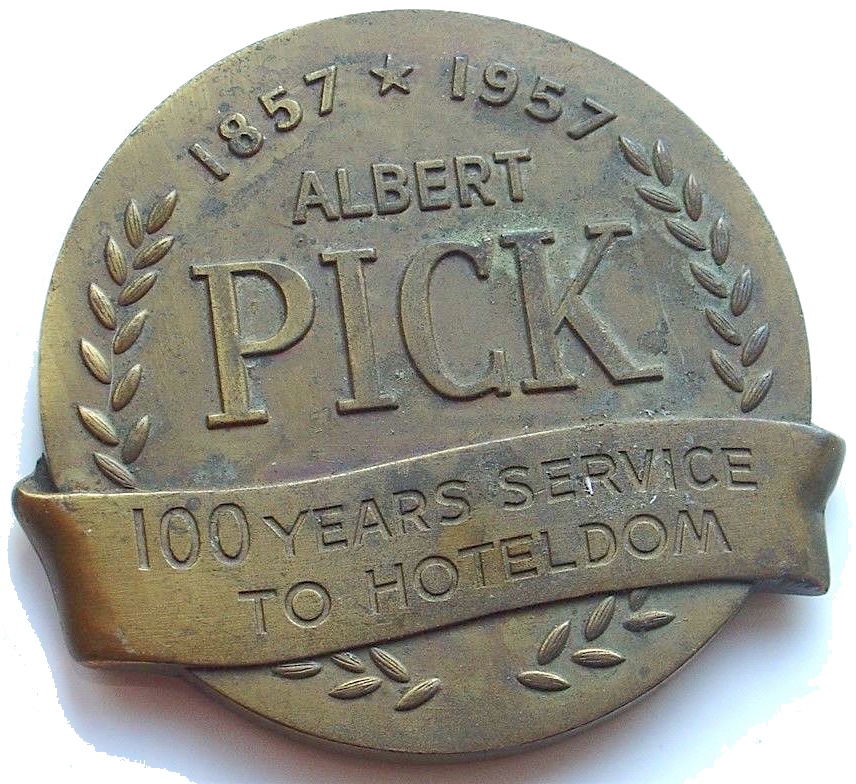 I suppose you could say that Albert Pick & Company were in the “hotel business,” or that they were one of Chicago’s great “merchandising houses” (back in the time when that phrase was widely used). But the advertisement quoted above really hits things more on the nose; Pick & Co. were problem solvers. For more than 100 years, this massively successful enterprise helped furnish and ultimately set the course for much of the American service industry—from the swankiest restaurants and lodgings to your everyday soda shops, billiard halls, and hospital / school / factory cafeterias.
I suppose you could say that Albert Pick & Company were in the “hotel business,” or that they were one of Chicago’s great “merchandising houses” (back in the time when that phrase was widely used). But the advertisement quoted above really hits things more on the nose; Pick & Co. were problem solvers. For more than 100 years, this massively successful enterprise helped furnish and ultimately set the course for much of the American service industry—from the swankiest restaurants and lodgings to your everyday soda shops, billiard halls, and hospital / school / factory cafeterias.
Inside Pick’s cavernous warehouse in Chicago’s Central Manufacturing District, an army of workers would sort and pick through endless stacks of inventory; a proto-Amazonian collection of goods shipped in from all over the country, covering any and every conceivable facet of their clients’ needs. For the hotel owner, this meant not only furniture, bedding, curtains, rugs, lamps, janitorial supplies, and bellhop uniforms, but the totality of their cafe/bar/kitchen requirements: from stoves, fryers, and fridges to chinaware, glassware, and fine silver.
 [The former Albert Pick warehouse at 35th Street and Racine has been marvelously repurposed in recent years as the home of the Bridgeport Art Center and the Chicago Maritime Museum]
[The former Albert Pick warehouse at 35th Street and Racine has been marvelously repurposed in recent years as the home of the Bridgeport Art Center and the Chicago Maritime Museum]
The item in our museum collection, which Pick provided for guests of the Sheridan-Plaza Hotel in Uptown back in the ‘20s, is one of those silver relics. With a hinge-top lid and a mere 8 oz. capacity, it certainly looks like what we might identify as a creamer or sugar bowl, but in fact—as revealed by Pick’s 1926 catalog—this was an “Individual Silver Coffee Pot”—a compact carrier for a shot of premium Jazz Age joe.
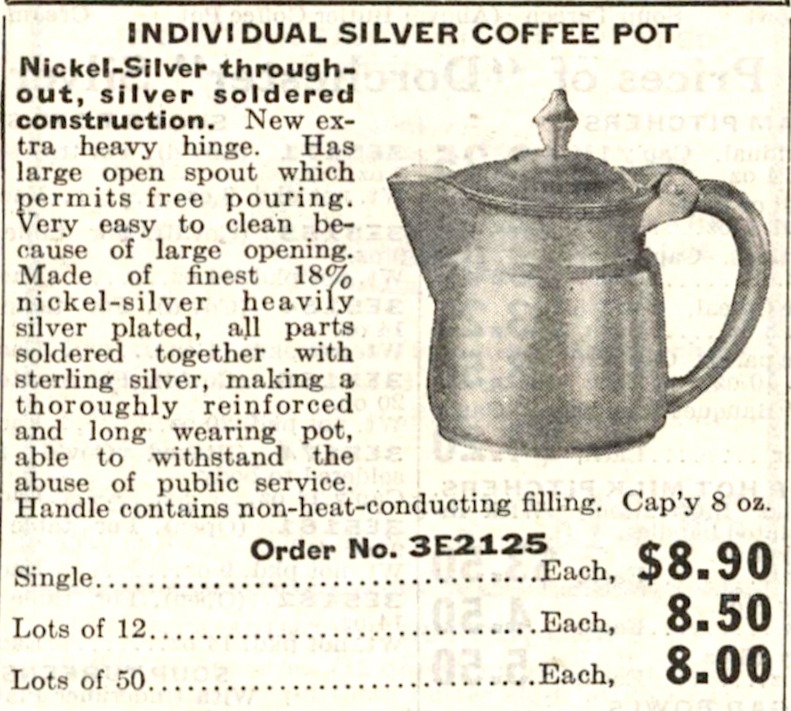 “Made of finest 18% nickel-silver, heavily silver plated,” the catalog states, “all parts soldered together with sterling silver, making a thoroughly reinforced and long wearing pot, able to withstand the abuse of public service.”
“Made of finest 18% nickel-silver, heavily silver plated,” the catalog states, “all parts soldered together with sterling silver, making a thoroughly reinforced and long wearing pot, able to withstand the abuse of public service.”
Quality didn’t come cheap. Just a single one of these baby coffee pots cost $8.90 in 1926, which comes out to more than $120 after inflation—not even counting extra costs for custom etchings like the “S-P” emblem on our Sheridan-Plaza artifact.
Part of that price tag was merely a consequence of Pick’s role as a middle-man distributor. Like many of the company’s products, our coffee pot did not originate in a Chicago factory, but instead came from one of the many far-flung subsidiary manufacturers that Pick & Co. had absorbed during its rapid expansion in the early 1900s. In this case, it was the E. H. H. Smith Silver Company, which was based in Bridgeport, Connecticut. Just about all of Pick’s silver was manufactured in Bridgeport, then shipped to the Chicago neighborhood of the same name, where it joined the other slate of goods in the Pick warehouse.
Bringing mountains of goods in by rail or ship was standard operating procedure for merch houses of the day, be it Sears-Roebuck or Hibbard, Spencer & Bartlett. But Pick, more so than those other giant institutions, had itself a wealthier niche clientele.
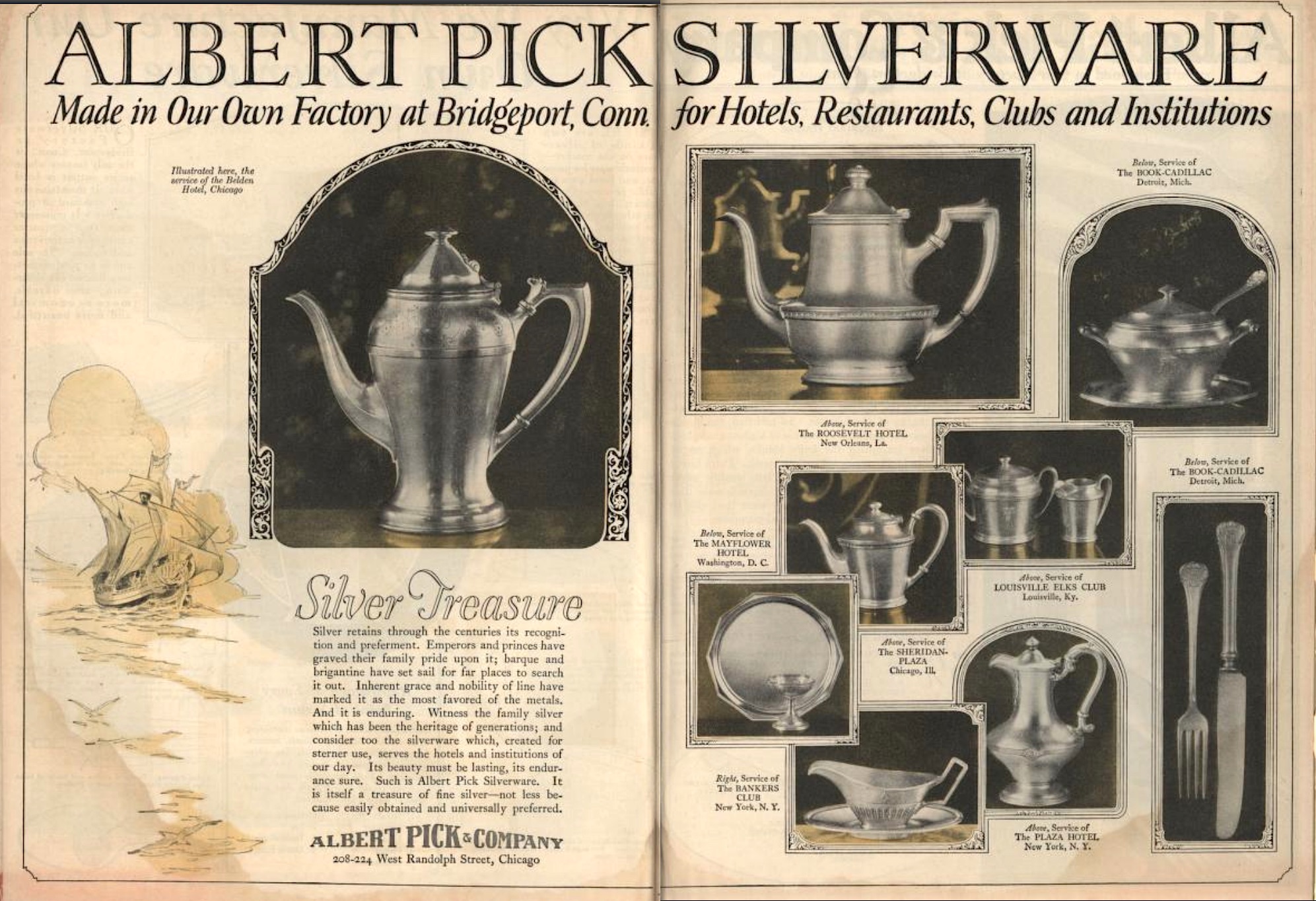 [While Pick’s central warehouse was located in Chicago’s Bridgeport neighborhood, its silver was coincidentally manufactured in Bridgeport, Connecticut]
[While Pick’s central warehouse was located in Chicago’s Bridgeport neighborhood, its silver was coincidentally manufactured in Bridgeport, Connecticut]
History of Albert Pick & Co. – I. “Little Things in a Big Way”
The first Albert Pick Company was organized way back in 1857, when a young Austrian immigrant—the original Albert Pick—opened “a little china and glassware business” on Randolph Street in what was then the frontier town of Chicago. “It was not a pretentious affair,” the company stated in a press release some 60 years later. “Nothing in the merchandising world was pretentious in those days, so far as Chicago was concerned.”
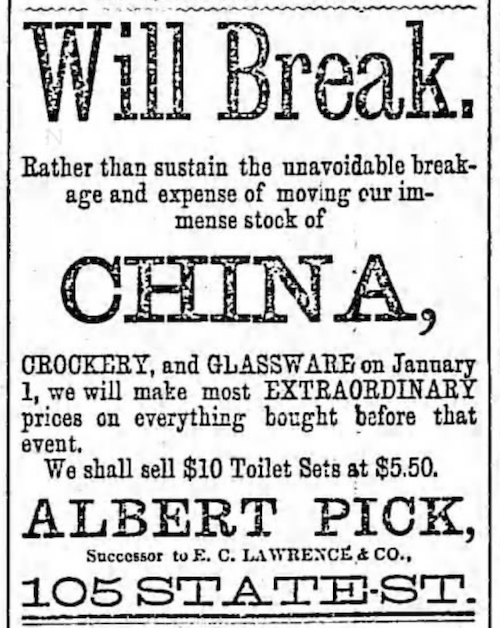 Pretentious or not, the Pick business was quite profitable—right up until the Great Fire of 1871 swiftly reduced it to rubble like so many others. Albert, being a proper dedicated Chicagoan, dutifully rebuilt [as evidenced by the goofy newspaper ad posted here from 1874, listing the business’s new State Street address], but it was his younger brother Charles Pick who largely carried the ball from there, eventually purchasing the store for himself and re-naming it Charles Pick & Co. It was only when Charles’s son took over the business in the 1890s that it reverted back to its original name. Reason being: Charles’s son had been named after his uncle, and thus, was also an Albert Pick.
Pretentious or not, the Pick business was quite profitable—right up until the Great Fire of 1871 swiftly reduced it to rubble like so many others. Albert, being a proper dedicated Chicagoan, dutifully rebuilt [as evidenced by the goofy newspaper ad posted here from 1874, listing the business’s new State Street address], but it was his younger brother Charles Pick who largely carried the ball from there, eventually purchasing the store for himself and re-naming it Charles Pick & Co. It was only when Charles’s son took over the business in the 1890s that it reverted back to its original name. Reason being: Charles’s son had been named after his uncle, and thus, was also an Albert Pick.
In 1896, the first year of Albert Pick II’s reign, gross sales totaled $90,000. Twenty years later, they topped $7 million, with a workforce of more than 1,000 men and women employed at the company’s home office (208 W. Randolph St.) and a constantly expanding Chicago warehouse (35th Street and Racine).
“The great factory and operating plant contains more than thirteen acres of floor space in the Central Manufacturing District in Chicago,” Monotype magazine reported in 1920.
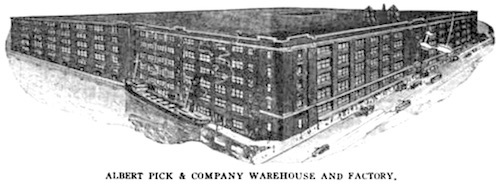 “Here are the warerooms containing entire outputs of other factories. The building is a model of convenience and utility; it has every device which will facilitate the rapid handling of merchandise. Through a complete system of lowerators, chutes and conveyors, and an organization trained to hair-trigger efficiency, Albert Pick & Company are able to prepare goods for shipment in a remarkably short time. The merchandise is loaded into the cars from private shipping platforms, adjacent to private switch tracks, that will accommodate fourteen cars at one time. They also have private docking facilities on the Chicago River—the busiest waterway in the country.”
“Here are the warerooms containing entire outputs of other factories. The building is a model of convenience and utility; it has every device which will facilitate the rapid handling of merchandise. Through a complete system of lowerators, chutes and conveyors, and an organization trained to hair-trigger efficiency, Albert Pick & Company are able to prepare goods for shipment in a remarkably short time. The merchandise is loaded into the cars from private shipping platforms, adjacent to private switch tracks, that will accommodate fourteen cars at one time. They also have private docking facilities on the Chicago River—the busiest waterway in the country.”
Having grown up in a post-fire Chicago with fewer ties to the Old World and its sensibilities, Albert Pick II seemed to lead the 20th century version of the firm with a new American sense of ambition, taking pride not only in conquering the big things, but in doing the little things “in a big way.”
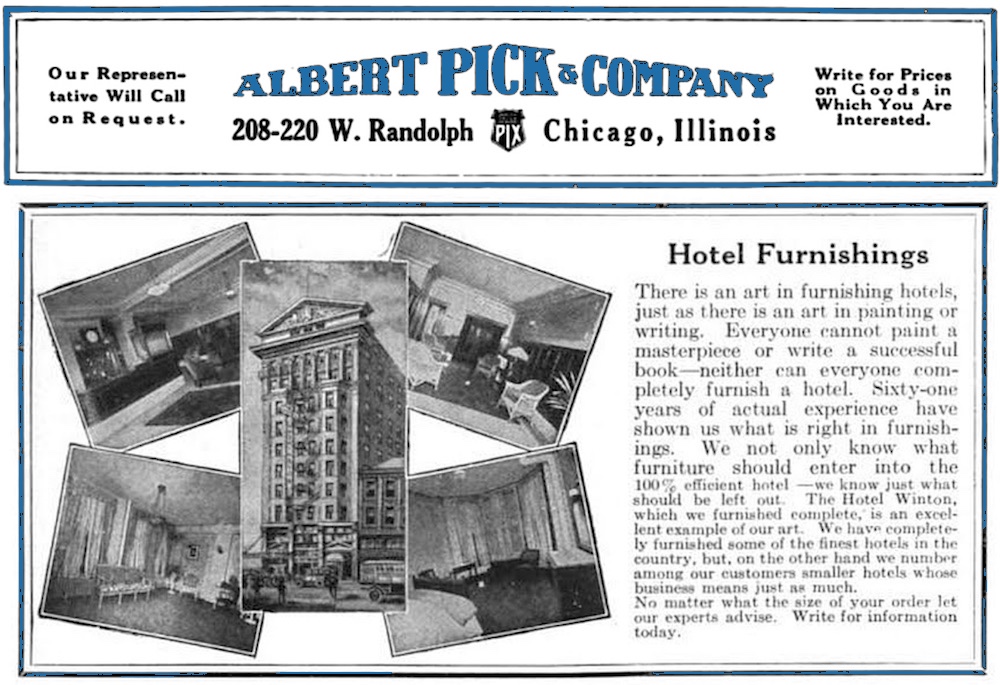
“There is an art in furnishing hotels, just as there is an art in painting or writing,” read a 1919 Pick advertisement, now sounding thoroughly pretentious at last. “Everyone cannot paint a masterpiece or write a successful book—neither can everyone completely furnish a hotel. Sixty-one years of actual experience have shown us what is right in furnishings. We not only know what furniture should enter into the 100% efficient hotel—we know just what should be left out.”
As Hotel World magazine put it, “Pick’s take a hotel as it comes from the contractors and equip it complete from the barbershop in the basement to the garden on the roof with everything in harmony.”
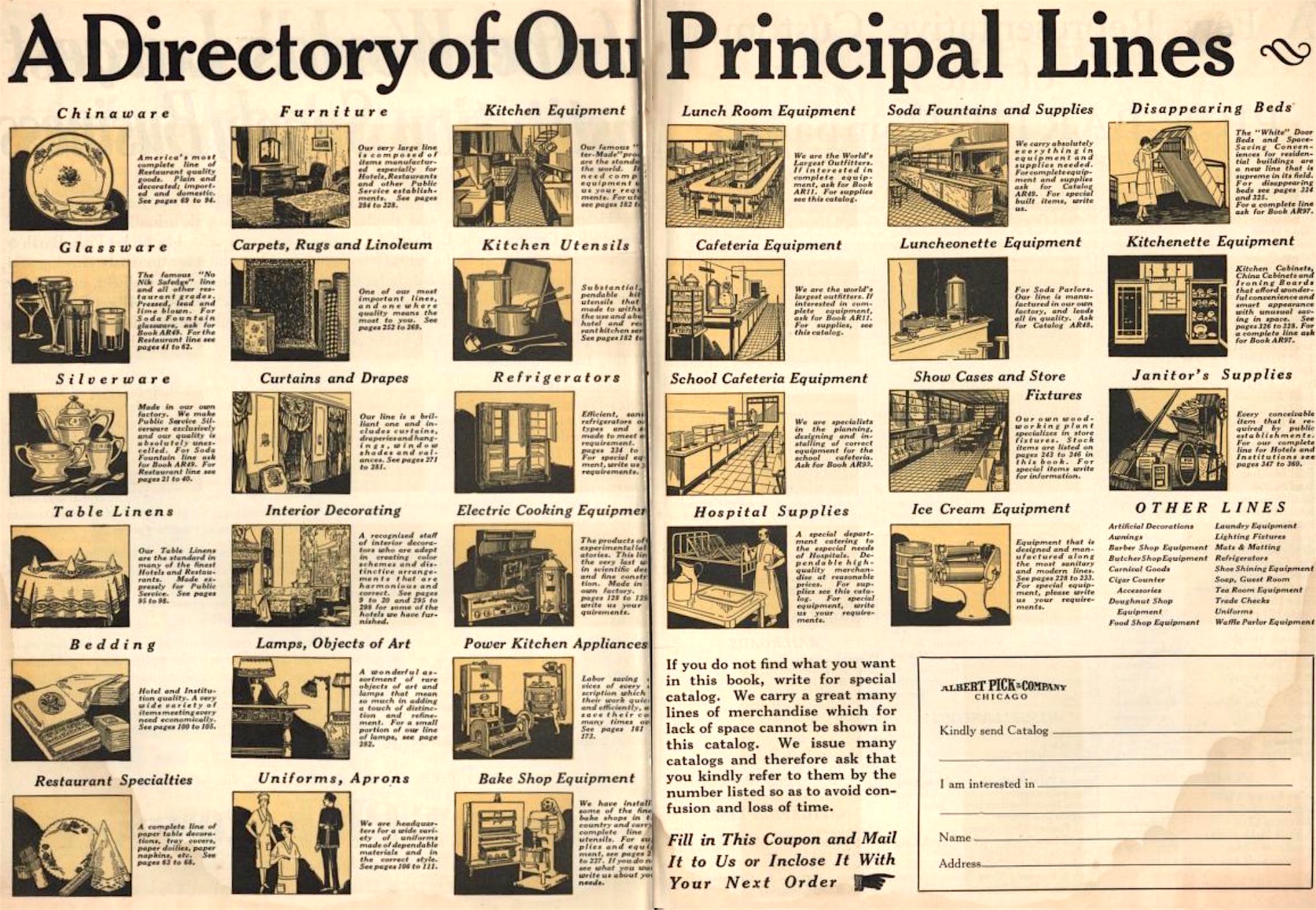
II. Pick of the Litter
With any large-scale business employing hundreds of people, it’s not always easy to say which individuals were truly most responsible for its success. As the nephew of the founder and the man with his name on the sign, Albert Pick (1869-1955) clearly was the one under the most scrutiny, but if you can believe the industry trade magazines of the day, he lived up to expectations more times than not. Hotel World, for example, while probably not the most unbiased source in the world (of hotels), wrote that “Albert Pick personally supplies an inspiring example of huge success coming to a man at middle age. Mr. Pick is a thinker—also an exceedingly active doer. He will not be ruled by impulse but he can size up the essentials of a proposition with amazing swiftness. Once he makes up his mind he acts with precision and exceeding boldness.
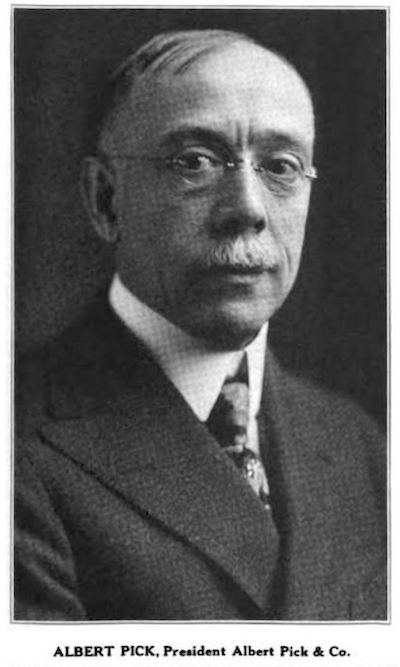 ‘“I never saw a man with such a memory,’ one of his co-workers declares. ‘Tell him a thing or read it to him and you can depend upon it that he will not forget it.’
‘“I never saw a man with such a memory,’ one of his co-workers declares. ‘Tell him a thing or read it to him and you can depend upon it that he will not forget it.’
“A brilliant mind, industry without end, and unusually attractive and forceful personality, pleasing geniality and executive ability of the highest order—all these has Mr. Pick.”
Gosh, why don’t you just marry him already, Hotel World!
Anyway, the facts do seem to support some of these assessments. Case in point, Pick took extra care to keep his workers happy in an era of violent labor unrest, even setting up programs for employees to purchase their own stock in the business. Similarly, the company had an “Industrial Service Department” set up for its clients, offering counsel and assistance in securing capital for growth and expansion.
Albert Pick went far beyond the “merch house” model established by his father and uncle. He planted roots, and they spread quickly.
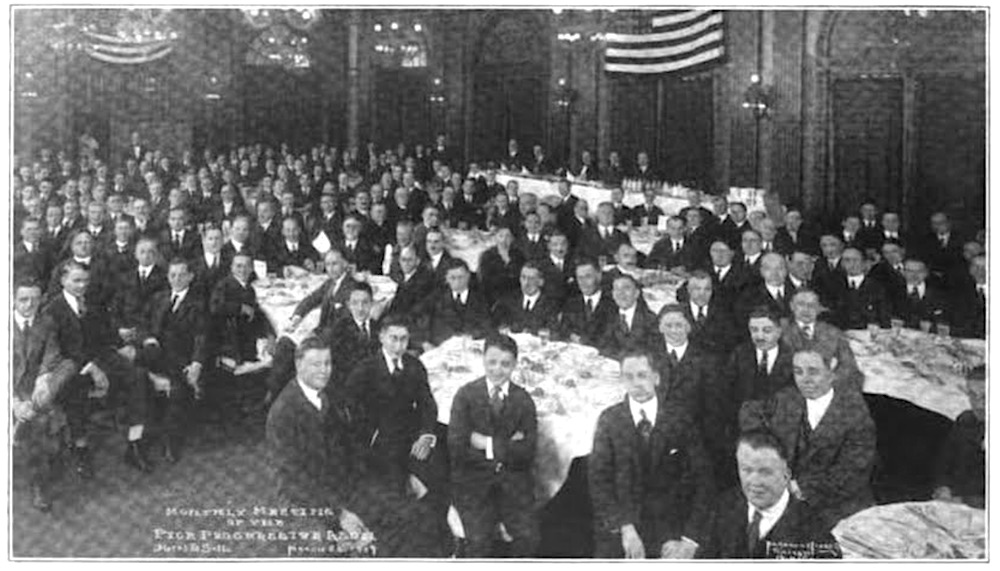 [Stock holders gather at Chicago’s Hotel LaSalle on March 26, 1919, to mark Albert Pick’s acquisition of Chicago’s Burley & Tyrrell Co. The two firms had been rivals in the china and kitchenware trade for decades, but would now work under one roof.]
[Stock holders gather at Chicago’s Hotel LaSalle on March 26, 1919, to mark Albert Pick’s acquisition of Chicago’s Burley & Tyrrell Co. The two firms had been rivals in the china and kitchenware trade for decades, but would now work under one roof.]
III. Big Business, Small Coffee Pot
The silver coffee pot from our museum collection, in its own small way, represents Albert Pick & Co. right at its most significant transitional period. Just after World War I, the company bought out its biggest Chicago competitor, the Burley & Tyrrell Co., and by the mid ‘20s, that move was dwarfed by an uber-merger with New York’s L. Barth & Company, forming the “World’s Largest Hotel Restaurant, and Institution Supply Business.”
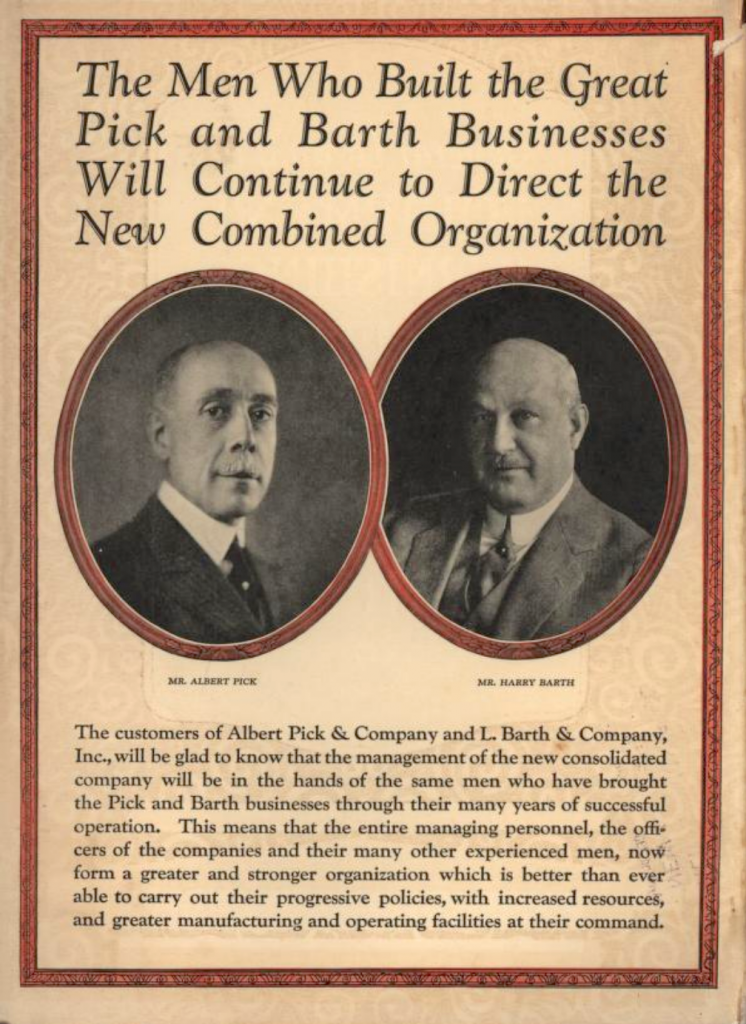 Together the East-West alliance of the “Albert Pick Barth Company” owned the outfitting contracts on hotels from Seattle to Miami, including icons like the Roosevelt and Ritz-Carlton in New York, and Chicago’s Drake, Blackstone, Palmer House, and Congress, not to mention the good old Sheridan-Plaza.
Together the East-West alliance of the “Albert Pick Barth Company” owned the outfitting contracts on hotels from Seattle to Miami, including icons like the Roosevelt and Ritz-Carlton in New York, and Chicago’s Drake, Blackstone, Palmer House, and Congress, not to mention the good old Sheridan-Plaza.
During the same period, Albert Pick (the man) was starting to invest more of his time and money into the real estate game, and his son Isidore—who preferred to be known as Albert Pick, Jr. (these folks had some confusing name situations)—was back from army service and eagerly learning the ropes of the family business.
Much of Pick & Co’s work before the Barth merger had involved game-planning around the new reality of Prohibition, and our coffee pot is emblematic of that effort, as well.
Today, having a self-service cafe or coffee counter inside a hotel is practically standard operating procedure. Back in the ‘20s, though, it was fairly new ground.
“The Sheridan Plaza Hotel cafeteria, Chicago, is a good example of how public opinion has changed in comparatively short time,” according to a 1921 article in Hotel World. “Less than five years ago, every manager and proprietor of a first-class hotel throughout the country felt sure that a cafeteria not only would ruin their cafe business but would cheapen and injure the good name of their hotels. Even later, with prohibition rendering useless large bar-rooms and grill-rooms ideally located for conversion into cafeterias, they still hesitated.”
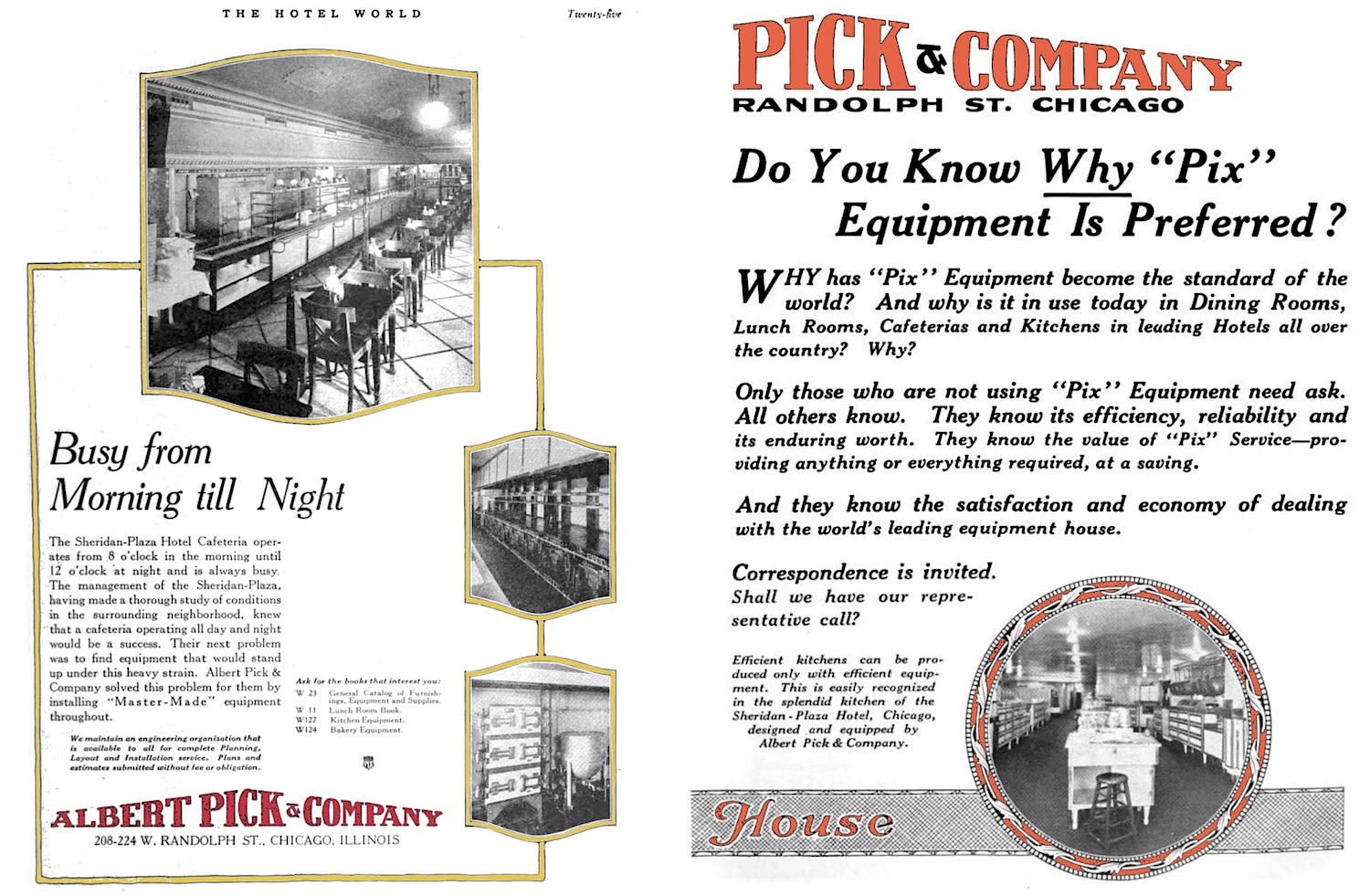 [Pick’s work on the Sheridan Plaza Hotel’s kitchen and cafeteria was clearly a point of pride in the early 1920s, as several ads, like the ones above, specifically used the results as selling points]
[Pick’s work on the Sheridan Plaza Hotel’s kitchen and cafeteria was clearly a point of pride in the early 1920s, as several ads, like the ones above, specifically used the results as selling points]
Once again, it was Albert Pick who was widely credited for being on the forefront on this issue, aggressively encouraging hotel clients to jump on the cafeteria and soda fountain bandwagons.
“It is characteristic of Pick’s progressiveness and courage that after they had arrived at the conclusion that the country inevitably would go dry, they boldly and bluntly spoke their sentiments,” Hotel World wrote.
Showing hotel owners that they could actually earn more money by replacing old bar rooms with more diverse alternatives, Pick also “went a step farther. They developed the cafeteria plan for the hotel also. This was kicking tradition over with a vengeance. . . . It takes just a little bold thinking and courageous application once in a while to rout out a lot of useless tradition and timid hesitation and thereby do a great work in behalf of net-profits.”
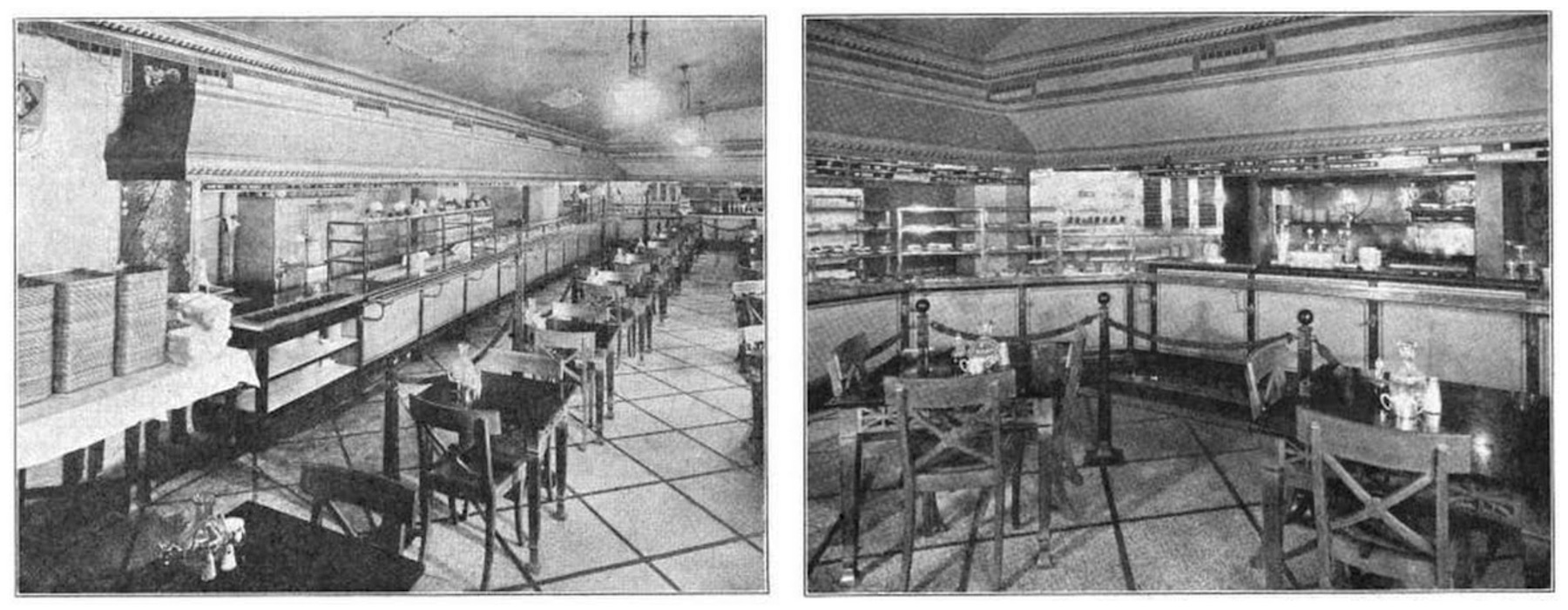 [View inside the Sheridan Plaza Hotel cafeteria, 1921]
[View inside the Sheridan Plaza Hotel cafeteria, 1921]
Our friends at Hotel World magazine were kind enough to include photos [above] of the Sheridan-Plaza’s then brand new Pick-equipped cafeteria in 1921, giving us some fuzzy views of the very room in which our surviving coffee pot might have spent its formative years. If you squint at the table tops in these images, you can nearly see our artifact—or perhaps its siblings—eagerly waiting to help a line-up of groggy North Siders shake out the morning cobwebs.
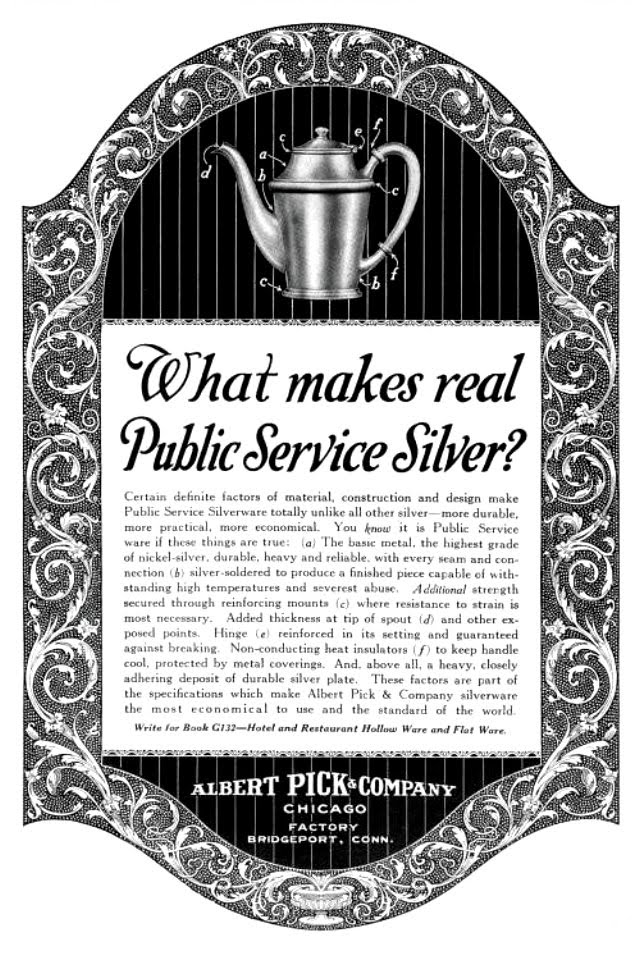 “Coffees and tea are served in silver pots with cream on the side,” the accompanying article states, adding that “silver and china are not of the plain variety; each is decorated and bears the crest of the hotel.”
“Coffees and tea are served in silver pots with cream on the side,” the accompanying article states, adding that “silver and china are not of the plain variety; each is decorated and bears the crest of the hotel.”
The Sheridan-Plaza, located at the corner of Sheridan Road and Wilson Ave., was right up there with the Edgewater Beach Hotel as a preferred hangout for high-rollers on the North Side in the ‘20s and ‘30s—positioned near the Uptown entertainment district (including the Uptown Theatre, Riviera, Aragon Ballroom, and Green Mill), the lake, and Wrigley Field (visiting players routinely booked rooms).
The building eventually fell out of favor and into disrepair by the 1970s, but it’s since been rehabbed into an apartment complex—a nice place, but not “etched silver coffee pot” nice.
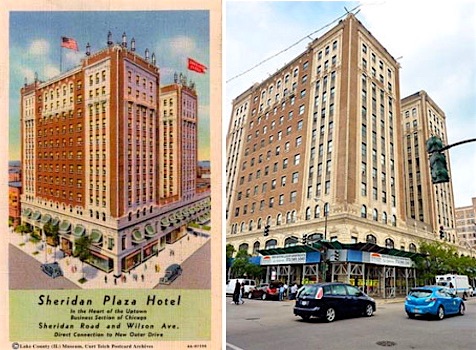
IV. Pick of Destiny
After the sale of the original business and merger with Barth in 1926, a new chapter for the Pick family really began, with third generation president Albert Pick Jr. (1895-1977) taking the lead.
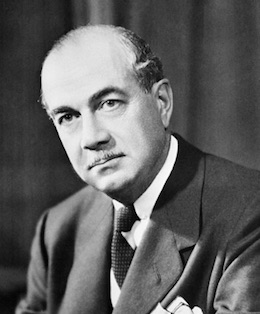 For all his well established wisdom, Albert Sr. hadn’t fully anticipated the financial collapse of 1929, and his side project, the Randolph Investment Company, began to suffer as a result. Fortunately, the nut hadn’t fallen too far from the proverbial hotel magnate, and Albert Pick Jr. was soon using his own considerable talents to guide the investment business though the Depression and into substantial post-war success as the “Pick Hotels Corporation.”
For all his well established wisdom, Albert Sr. hadn’t fully anticipated the financial collapse of 1929, and his side project, the Randolph Investment Company, began to suffer as a result. Fortunately, the nut hadn’t fallen too far from the proverbial hotel magnate, and Albert Pick Jr. was soon using his own considerable talents to guide the investment business though the Depression and into substantial post-war success as the “Pick Hotels Corporation.”
Part of the business still involved equipping other facilities, but after all these years, Albert Jr. felt it was high time for the company to start owning and operating its own hotels, not just teaching other people how to do it.
“I don’t mean to be egotistical,” Albert Jr. said in his later years, “but I don’t think there is a name in the hotel business, nationally or internationally, that’s better known.”
Indeed, he might have been right for a while. During the 1940s, Pick Hotels Corp. gradually acquired an impressive roster of high-end hotels under its own banner (mostly in the Midwest), including Chicago’s famed Congress Hotel. Later into the ‘50s, the company jumped into the motel business, recognizing the popularity of more affordable accommodation options along America’ expanding highway system.
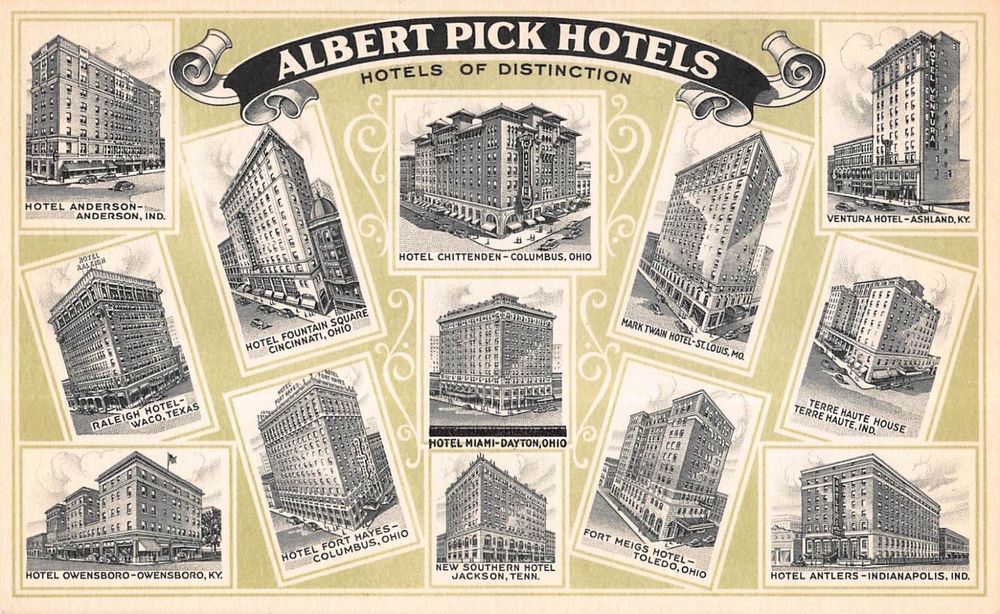
[Pick’s “Hotels of Distinction” (above) included many of the great high-rise accommodations from the Golden Age, while their chain of motels, like the one in Nashville below, represented an attempt to adapt to a highway-centric America in the 1950s]
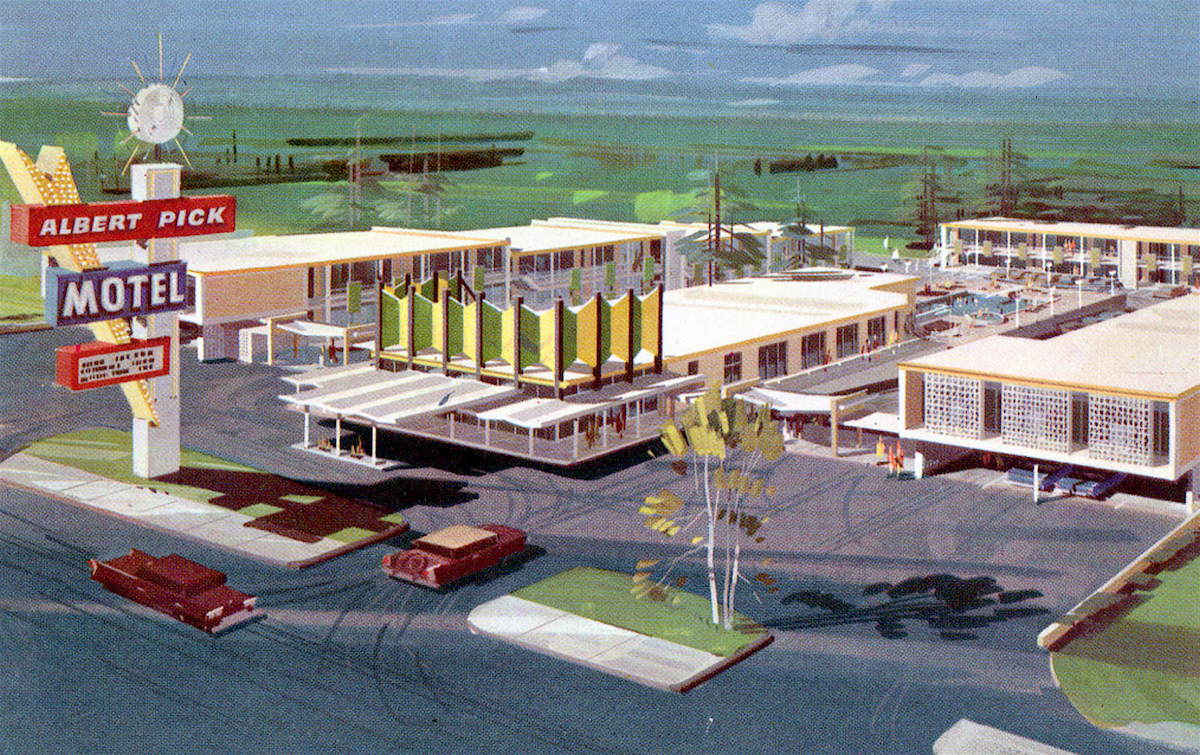
As late as the 1960s, Pick still represented one of the largest hotel/motel chains in the U.S., and Albert Pick Jr. was using his influence for plenty of good in his hometown, particularly in the form of support for the La Rabida Children’s Hospital and his alma mater, the University of Chicago (a hall at UC is still named in Pick’s honor).
The only trouble ultimately, as ever, was Father Time. In a rare bit of short-sightedness, the Pick company wasn’t fully prepared when its turn-of-the-century hotel properties—the same elegant buildings they’d furnished in the good old days—began rapidly declining. In the swinging ’60s, out-of-date hotels with deteriorating features didn’t quite hold the same appeal for businessmen or vacationing families. And while Pick’s far more modern roadside motels would seem to fill that void, the juggling act became a struggle.
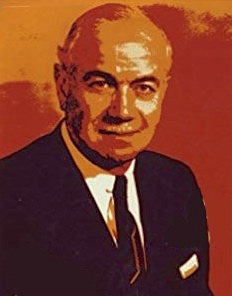 Albert Jr. did his best to keep things going, remaining active in the business up to the age of 81, when he finally sold the Pick Hotels Corp. to a Texas oil company, Bass Brothers Enterprises, in 1976.
Albert Jr. did his best to keep things going, remaining active in the business up to the age of 81, when he finally sold the Pick Hotels Corp. to a Texas oil company, Bass Brothers Enterprises, in 1976.
“Hotels have been my life,” he said at the time. “I will miss it. However, I’m not a child anymore. It may have been wiser to have sold out when I was younger and taken things a little easier, but that’s not my nature.”
Albert Pick Jr. died the following year. In the half century that’s followed, the Pick name has sadly been mostly forgotten, right along with the attention to detail that once defined the American hotel industry.
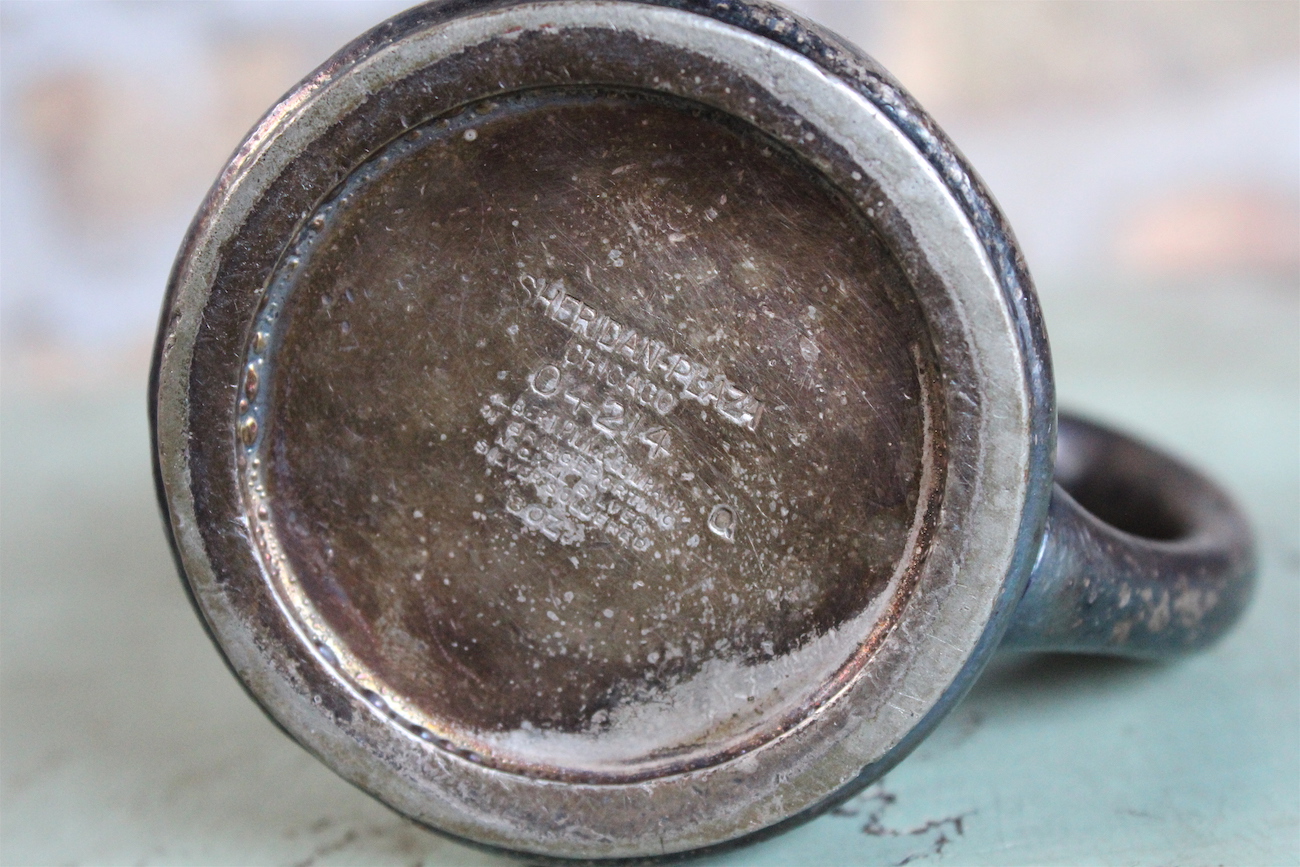
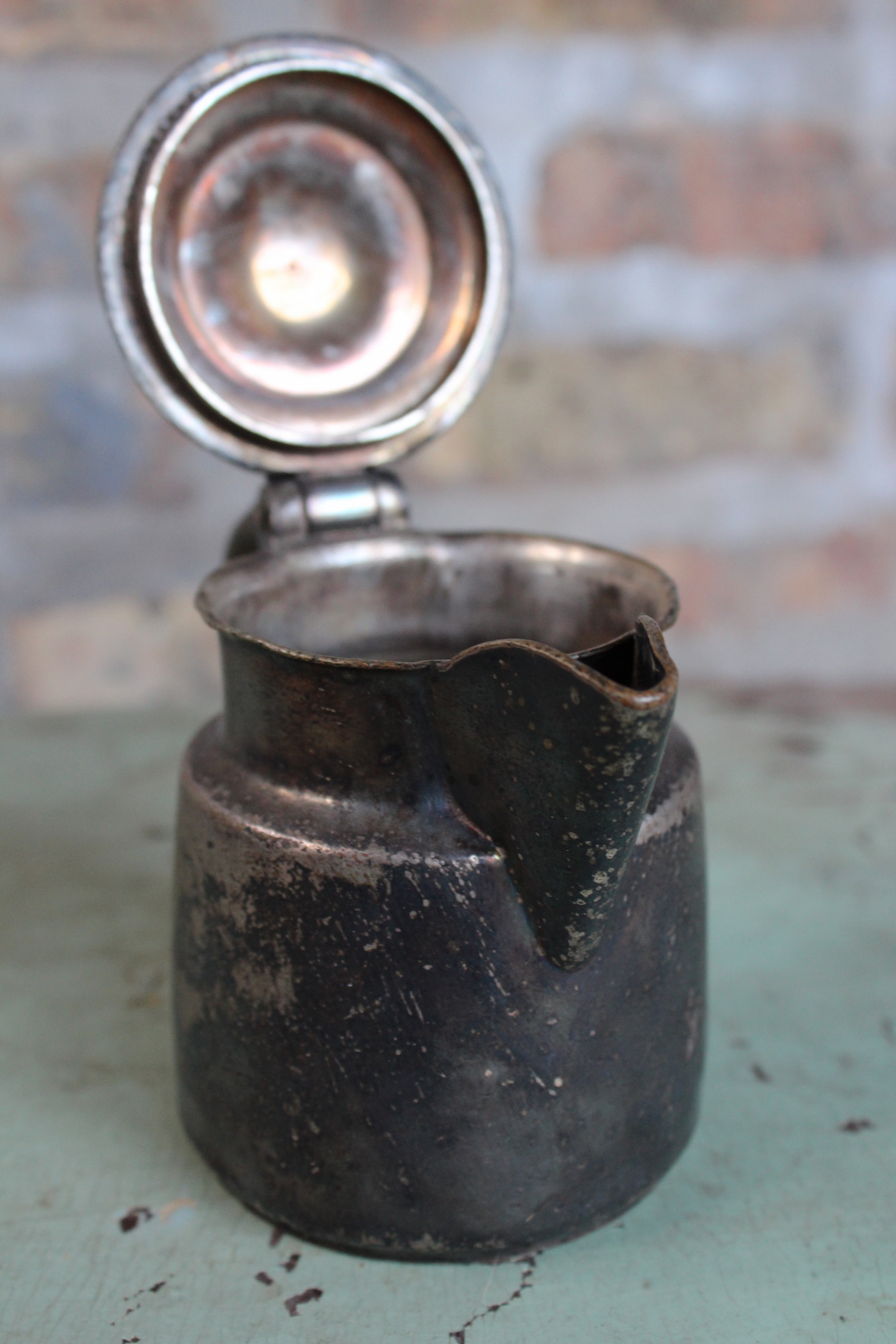
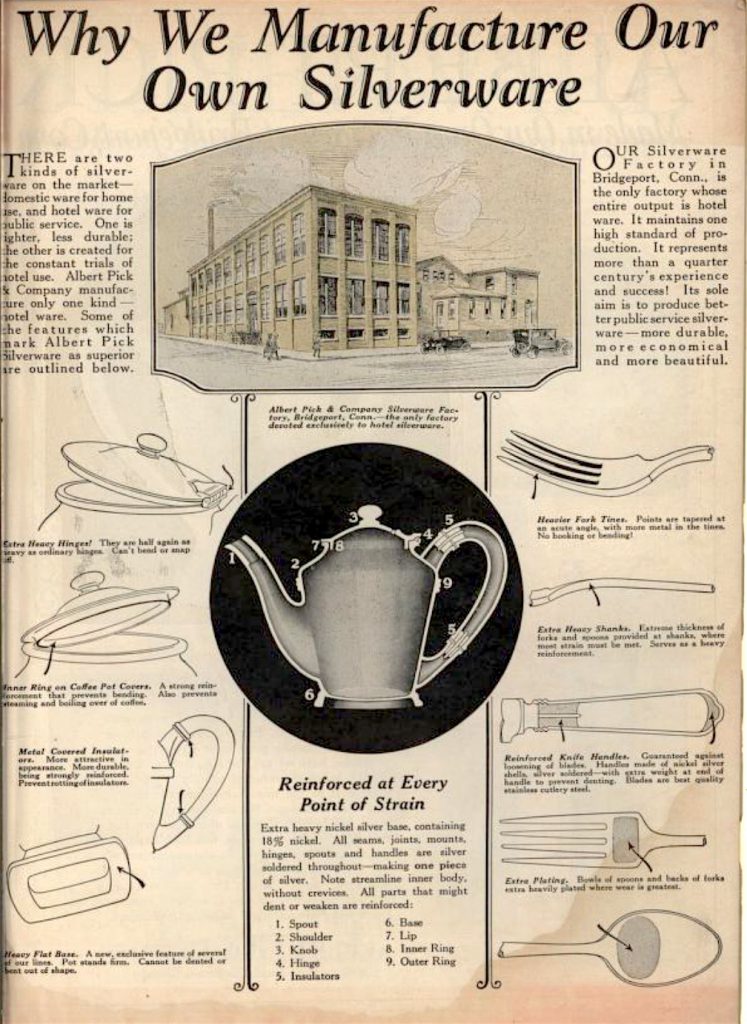
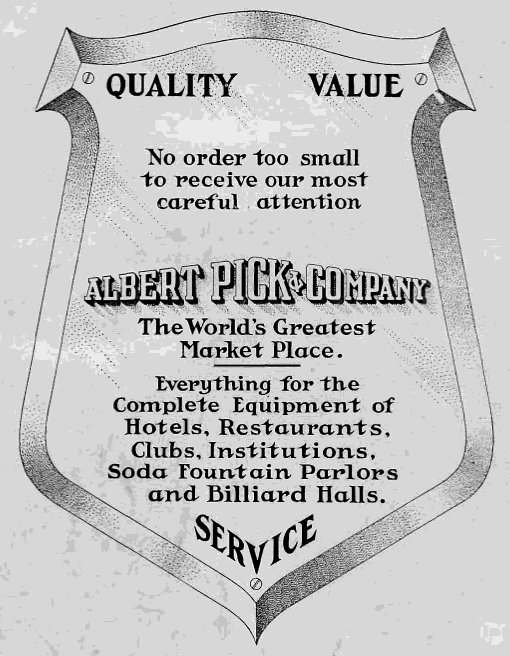
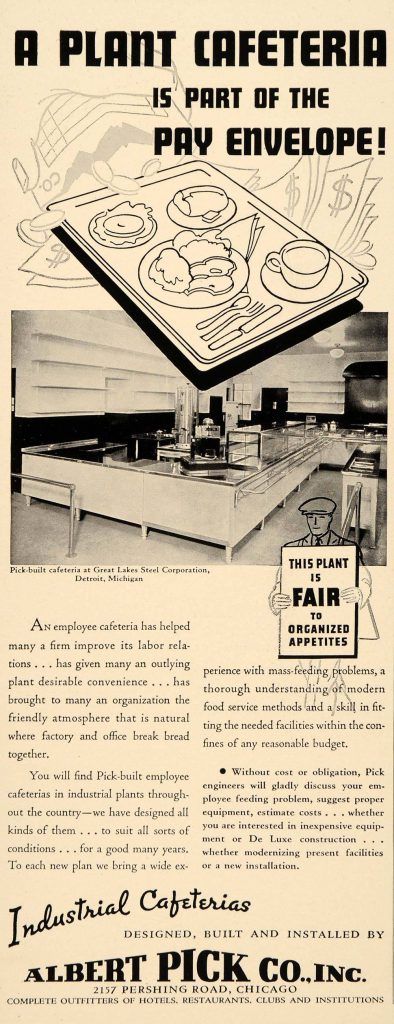 [This ad from 1937 finds the Albert Pick Co., Inc., in its mid Depression form, just before a shift into hotel acquisition and operation. The listed warehouse at 2157 W. Pershing Road, also in the Central Manufacturing District, was first leased in 1936]
[This ad from 1937 finds the Albert Pick Co., Inc., in its mid Depression form, just before a shift into hotel acquisition and operation. The listed warehouse at 2157 W. Pershing Road, also in the Central Manufacturing District, was first leased in 1936]
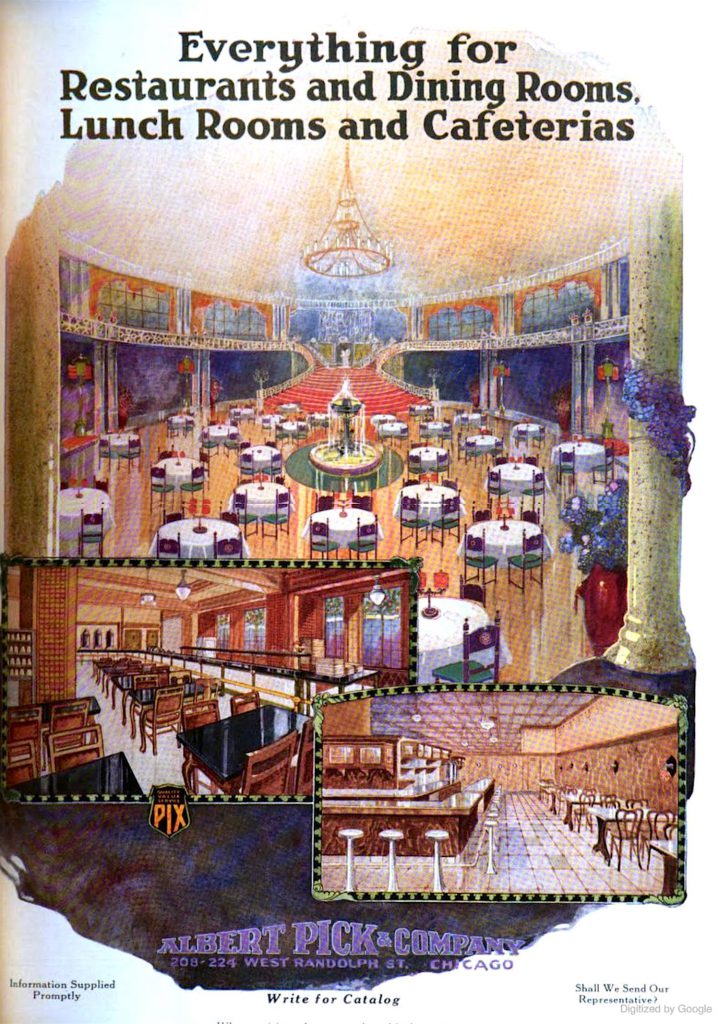
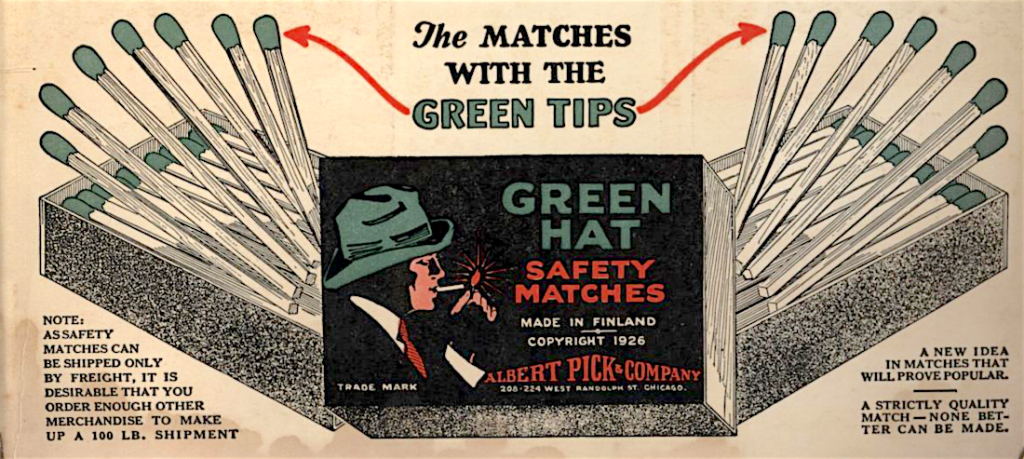
Sources:
“Albert Pick Jr.” – Accuracy Project
The Indestructible Crown: The Life of Albert Pick, Jr., by Judith Barnard, 1980
“Pick, Hotel go together like Horse, Buggy” – Chicago Tribune, Oct 9, 1976
“The Cafeteria a Profitable Adjunct to Hotel” – Hotel World, Vol. 93, No. 25, Dec 17, 1921
“The Albert Pick Co.” by Mike Prero, Matchpro.org
“Albert Pick Jr., Hotel Chain Founder, Dies” – Chicago Tribune, Dec 12, 1977
“Busy From Morning Til Night” – Albert Pick ad, Hotel World, Vol. 93, No. 10, Sept 3, 1921
General Catalog of Equipment, Furnishings, and Supplies for Hotels, Restaurants, Club and Institutions, Albert Pick & Co., 1926
“The Monotype Made It Possible” – Monotype, Vol. 8, No. 2, May 1920
“Consolidation of Two Great Hotel Supplies Houses” – The Hotel Monthly, April 1919
“Albert Pick & Co. Expand Facilities” – The Hotel World, Vol. 89, No. 2, August 2, 1919
Archived Reader Comments:
“I really enjoyed this story of the Albert Pick Co. I just bought a plate with Liberty Vitrified China, Albert Pick Co. Inc. on the back and thought it would be fun to research it. First I went to Ebay and then to the web generally. I love hotels and restaurant china so I appreciate this work of Andrew Clayman with all the great pictures and quotes. Thank you! 
 ” —John Comstock, 2019
” —John Comstock, 2019

What a wonderful story. Business giants have always fascinated me. I have a coffee cup that has printed on the bottom m, AlbertPICK Co Inc.
CHICAGO
Verified CHINA
We have an Albert Pick ‘Full Dinner Pail’ with handle collectible. The lid is missing. The Pick Manufacturing Company sold these as inexpensive Holiday Souvenir Novelty shot glasses touting them to be the ‘Cleverest, Most Unique and Catchy Liquor Receptacle Made.’
Further, the Republican campaign slogan in the 1900 Presidential election campaign was ‘Full Dinner Pail’, used to emphasize prosperity under McKinley’s first term and to particularly appeal to the labor vote. McKinley was re-elected with Teddy Roosevelt as Vice-President.
Our grandmother who passed away at 95 in 2000 was the owner. We are interested in selling, Thank you.
Tengo en mi poder una jarra pequeña
HOTEL LINCOLN – 1926
Albert Pick & Company
Chicago
Silver Plated On Nickel Silver
5184
8oz
I have a Albert Pick & Company 1 1/2 oz nickle Silver shot glass with the initials ONTRA or DNTRA. The T is large in the center and the first /left letter looks like a backwards D. Any idea what business it came from?
I have a large shard of what looks like a white platter with two thin green lines near the rounded edge. The mark on the bottom says PIX ECONOMY HOTEL WARE Albert Pick &Company CHICAGO inside the shield-like outline. It does not have a star below the point at the bottom. About what period of time would this be from? I found it in an old fill area being trenched along the Mississippi River in Davenport IA.
I have an Abert Pick & Co. Extra – Gravy Spoon/Ladel Been in family for years but can’t tell how old or where from Plain Pattern ….Anyone have any ideas or value….cleaned up nicely
I have a small plain square 2-7/8 x 2-7/8 inch tray that was handed down in my family for several generations. On the back it is marked:
ALBERT PICK & COMPANY
Chicago
SILVERPLATED ON NICKELSILVER
I’d like to know when it was made and what it was used for. It is not in the 1918 Saloon catalog. Thanks
I have an Albert Pick shipping create in great condition. If anyone is interested in purchasing this item, please reach out.
picklegal14@yahoo.com
I have a solid maple butcher block table from the Albert Pick Co. It is 3ft x 6 ft, and 3 inches thick. I’m looking to sell it if anyone is interested. Local pickup only. Chicago suburbs. Lori.Linehan@gmail.com
I have (3) ALBERT PICK CO platters dated 1926. My grandfather used them in his restaurant many, many, many years ago.
vitrified china, chicago buffalo china / checkerboard border.
I have a 04204M Albert Pick Co Inc 18% Nickel Silver Soldered 64 oz 2Q Teapot. Does anyone know anything about this? Price? Age? Thank you!
I have a Wagner Ware water pitcher with Albert Pick & Co stamped along with it on the bottom. Rather roughly made looking with a finger grip in the back and a wooden grip on the wire handle. The pitcher is actually in pretty good shape. I can’t find another exactly like it. I can’t find any other Wagner Ware piece that has Pick’s name. Would love more info on it.
I found a hanger from one of the Pick Hotels in my grandparents things. Did some research and ended up here. This won’t allow photos but it appears to be hand made.
Can you tell me the dates Albert Pick & CO -A – Sect George Washington pattern was made? I am looking for info on a tea spoon marked HOTEL WABASH. Did Albert Pick ever make such flatware for the Wabash Railroad hotels?
314-225-7206
I have Albert pick 10oz teapot I don’t know where to find more information about that
I have a footed cup w/ one handle marked w/ a K in a crest.
Albert Pick and Co
Kramer 03308
Nickel Silver
Any information would be appreciated as well as value.
I have a “Cloth Cleaner” with a list of cities and hotel names printed in red on it – from an Albert Pick Hotel. Not sure how old it is, but it’s pretty cool.
I have a white terrycloth bath towel with a blue ribbon lengthwise through the center that says Albert Pick Hotels. No holes or tears and not threadbare so it probably dates to the latter years of the motels/hotels.
Hi. My husband brought home a Hotel Keenan Albert Pick and Company 8oz nickle silver silver soldered bowl. I am trying to find more information on it. I know it was from the Hotel Keenan in Ft. Wayne In.
I have an Albert Pick Co Chicago Wood Divided Box with double handles and metal corners. 20″ x 12″ x 4″. Wt. 7 lb. Solid wood. Is it of any value to a museum?
I have a small finger type bowl. White with green design. With a small protruding area off one side of bowl. It says on the back. vitrified acme china woods & sons england furnished by albert pick company chicago. Can you please tell me where I can find info on this bowl. I could send a pic if that would help. Thank you very much
I have a beautiful Albert Pick & Co nickel silver tea (coffee?) pot that hangs on a stand (2 knobs on each side sit on the uprights of the stand, for pouring) with warming flame underneath. I would like to find out more about this piece if at all possible, and can provide photos.
Hi,
I have a single Pick & Co bowl I’d like to verify the origin of, if possible.
It is a cafe type, with some crackling around top edge and is decorated with a band of thin red and yellow lines and a green border pattern of (greek-like) square spiral pairs around the circumference of the bowl – and the name O’LEARY’S in caps at center/front.
As a child I was told this was from THE O’Leary family’s later home or business, which I found dubious – but would like to verify it’s actual origin if possible.
Thanks for any information or attention to this request.
Look up O’Leary’s Saloon, which was owned by a member of the O’Leary family whose house started the Chicago Fire (supposedly). Here’s the link: https://chicagology.com/notorious-chicago/olearys/
I was wondering the age on a nickle silver corn Cobb plate, marked Francis Marion hotel, chas SC
Also is stamped with a number 04550
Hi! I have been trying to find the value of an Albert Pick and Company dresser. I have found very little in the way of APC furniture and not a thing about this dresser. There seems to be only one other APC dresser online and it is not similar to the one I have. It has 3 full drawers and 2 half drawers on the top. The half drawers and the first full drawer have keyholes. I would think for a skeleton style key. Any information would be helpful! Thanks in advance!
Great page for trying to research an item of American hotel chinaware not often seen this side of the Pond. Small footed white comport marked – Vitrified Ware – Manufactured Expressly For ALBERT PICK Company Chicago By Cauldron Ltd ENGLAND. Item is decorated in a thin Red/Green/Red strip and logos I read as HCA inside a laurel leaf garland with ribbon. The item and decoration very 1900/1920’s. Would like to know please what hotel this item originated from….thank you.
I have a Albert Pick 7tt 10″ stainless steel commercial kitchen counter top with deep drawers on bottom left and slide doors on bottom right.
I want to sell it, but I have no idea what it’s worth, Or if it’s rare.
Please advise!
Melea
Hi I have 2 pieces I is an ash tray with Albert Pick on it the other oiece same color is 15 3/4 inches long . A vase with 2 women on each side vase in the middle light purple in color . Can you tell me how old and when it was made?
Thanks
A. Gibson
I have an albert pick & company branded pool table, looking to see if there is any value. Is in decent shape
Looking for a coffee server I have. What era an value I can send a photo
I have an Albert Pick & co extra Brown Hotel Tsp.Looks like a hammered handle How much is it worth?
I have a saucer thst I would love to know more about. It says Albert Pick, Chicago . And has Warwick mark ad well.
On the front are tiny shamrocks or clovers in green…I have looked for years and have never seen anither piece with thus design.
Mr Pick became an investor in the Golfmore land Corp with founder Joseph A Roseman Sr, my grandfather, (Wikipedia him), It was a Golf Course design build co, which by default was a large land tract acquisition company- for golf courses. Because, in the end If the course was non longer profitable or, if just because the land value has increased 10+ fold in 30 years, it’s value was far greater than the daily fee golfer (less high course maintenance costs). Many fine courses were laid out and are still in operation today, but not all.
To honor his big investor, Joe Roseman named his next big project after him in the 36 hole “Pickwick Golf Course” AKA just Pickwick. It later became (part) of the Glenview Naval Air Station in the north suburb of Chicago. The Navy having come and gone kept the one 18 hole golf course for soldier/sailor recreation. All the land of GNAS was ceded to the village when the base closed in about 1996. The subsequent redevelopment of the former base included the golf course being preserved and completely rebuilt and is now called The Glen Club. Famed golf course architect Tom Fazio turned it into one of Americas top 100 courses in the nation.
Several televised sanctioned tournaments are played ther annually.
Phil Roseman
Great article! Fun to read some of the details about the history of “Albert Pick & Company”.
For anybody interested I scanned in a copy of a 1918 catalog, which you can see here: https://drinkboy.com/digitallibrary/AlbertPick/
It is interesting to see the variety of products that they were selling just prior to American Prohibition, as well as how near the end of the catalog they provide recommendations for how folks can turn their soon to be defunct bars into a new business.
I have the same pattern-Warwick creamer. Hard to find.
I have an original certificate of 60 shares of Albert Pick & barth, CO inc dated 03/12/1929. I this worth anything?
I have a tiny creamer with a 1″ band decoration of a fox hunt, complete with a bounding horse and rider, dog(s) and possibly a treed fox. The backstamp is “WARWICK ALBERT PICK COMPANY CHICAGO COPYRIGHTED.” A couple plates marked WARWICK, but not the same pattern, have surfaced, but no information about the WARWICK name. Does anyone have any insights?
I am a chicago beachcombing archeologist. I have found over 100 pieces of China dishes with the makers mark “Albert Pick Co, Chicago” along lakefront beaches particularly in Wilmette. Is there any way to trace the China pattern and which hotel(s) it was used in? (Or where the dump may have been where this China made its way into the lake)?
I have an Albert Pick-Barth Company Inc. with a word under, hard to tell what it says but looks like Offers. It is silver plated or nichol that I am trying to find out more about.
I would like to sell some water and small (Brandy/sherbet) goblets of Albert Pick. They are silver plated nickel. There are at least 10 of each. Can not find any info or pictures of them anywhere. I am not able to get a picture in this comment box.
This is a fantastic page! Thank you so much for putting it together!
I’m trying to find out some info on some flatware, marked Albert Pick, hammered pattern, about 68 pieces.im trying to find out if they are silver or silver plated, and a possible value..thank you
I’ve uncovered a Oak 48” round table with the decal “Albert Pick & Company”
Chicago from my garage. It’s been there since we bought the house in (Brookfield) in 1997. Do you think it’s worth anything?
I have a small fork (don’t know the proper name for it) that has
ALBERT PICK HOTELS on the back made by International & Co. I bought it in St. Louis about 1974.